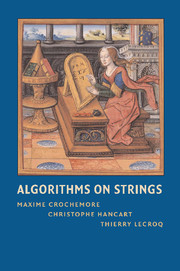6 - Indexes
Published online by Cambridge University Press: 03 October 2009
Summary
The techniques introduced in the two previous chapters find immediate applications for the realization of the index of a text. The utility of considering the suffixes of a text for this kind of application comes from the obvious remark that every factor of a string can be extended in a suffix of the text (see Figure 6.1). By storing efficiently the suffixes, we get a kind of direct access to all the factors of the text or of a language, and this is certainly the main interest of these techniques. From this property comes quite directly an implementation of the notion of index on a text or on a family of texts, with efficient algorithms for the basic operations (Section 6.2) such as the membership problem and the computation of the positions of occurrences of a pattern. Section 6.3 gives a solution under the form of a transducer. We deduce also quite directly solutions for the detection of repetitions (Section 6.4) and for the computation of forbidden strings (Section 6.5). Section 6.6 presents an inverted application of the previous techniques by using the index of a pattern in order to help searching fro itself. This method is extended in a particularly efficient way to the search for the conjugates (or rotations) of a string.
Information
- Type
- Chapter
- Information
- Algorithms on Strings , pp. 219 - 242Publisher: Cambridge University PressPrint publication year: 2007
